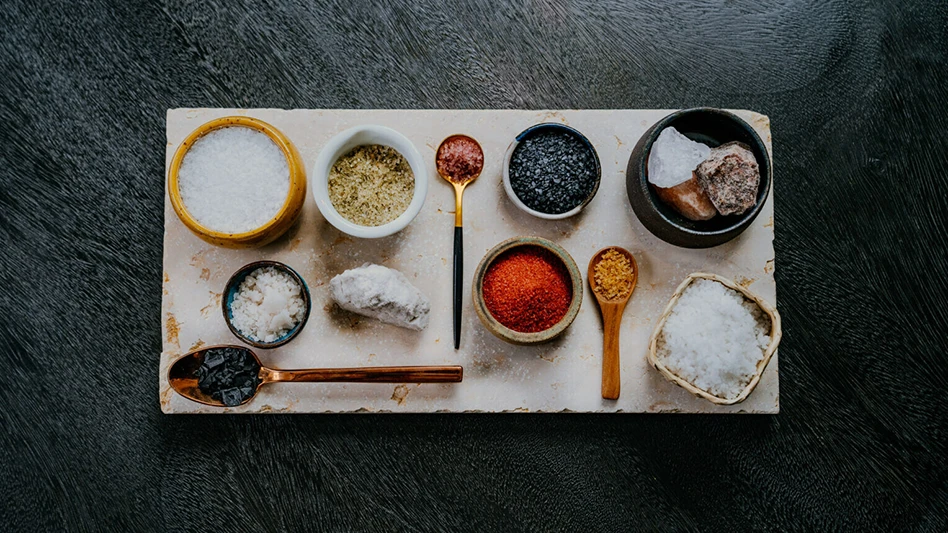
Photo courtesy Kimpton
ATLANTA — Kimpton Hotels & Restaurants, part of IHG Hotels & Resorts, released its annual Culinary + Cocktail Trend Forecast, highlighting predictions from its team of global culinary and beverage experts that will be featured on plates and menus in 2024. From global salts and “seacuterie” to textured cocktails and umami flavors, Kimpton is forecasting both new and evolving trends that will further enhance the dining experience.
SALT WITH A STORY. While salt is one of the most common ingredients in cooking, expect to see a noticeable shift to unrefined salts (black Hawaiian salt, kala namak, Persian blue salt, Celtic salt, fleur de sel) as consumers move away from table salt staples in search of something more unique to add to their dishes.
Sourcing will also be a priority for many chefs, working with global salt producers to identify salts from around the world and understand their history and use cases.
TINNED FISH AND ‘SEACUTERIE’ BOARDS. In the last year, luxury tinned fish sales have soared as people embrace seafood’s diverse range of flavors and sustainable practices. Expect to see more unique conservas on charcuterie boards as well as dedicated “seacuterie” boards including samplings of luxury canned fish like Spanish sardines in olive oil, habanero smoked oysters and Maine eel smoked in alderwood packed in California olive oil.
CABBAGE TAKES CAULIFLOWER’S CROWN. Cabbage will take over plates as culinary professionals and consumers alike turn to the cruciferous vegetable for its versatility, taste and texture. Both well-known varieties such as Napa, savoy and red cabbage and the more coveted Caraflex or conehead cabbage will be showcased in a multitude of ways on menus including charred, fermented, roasted, braised and caramelized.
CREATIVE DRY AGING. The technique of dry aging has grown in popularity and is increasingly sought after by consumers. Leveraging the proper equipment, dry aging provides enhanced control of texture, adds depth of flavor and complexity to elevate any dish.
With dry aging, chefs are able to push beyond beef into more interesting dishes with duck, lamb and fin fish. Vegetables like beets and carrots are being dry aged with koji to create a charcuterie-like texture and flavor. Even spirits like bourbon and gin are being treated with dry aging techniques to take cocktails to the next level.
PASTRY IS BACK. Consumers are saving room for dessert as chefs roll out inventive confections. Kimpton is particularly seeing a rise in Asian and French influences for the sweetest course.
Guests can expect to see a rise in sweet and savory combinations, such as carrot mochi and chocolate smoked salt croissants with alternate sugars like date-based sugar, beet sugar and coconut sugar growing more prominent.
TEXTURED COCKTAILS. Rose and pistachio dust, dragon fruit crisp and edible helium bubble clouds are some of the sensory ingredients diners will soon find on bar menus in 2024 to add texture and visual appeal to the liquid base.
A NEW WAVE OF UMAMI. Kimpton bar leaders predict more experimentation with different types of fat washing as a new way to create smooth, creamy and velvety undercurrents in spirits rather than more traditional sweet syrups. Expect to find creations like a salmon martini or beverages using unique washing ingredients such as duck confit and spam.
PANTRY INGREDIENTS IN COCKTAILS. Bars will incorporate ingredients from the kitchen to level up cocktail and non-alcoholic beverages, including biquinho peppers, salsa macha, soy sauce, fish sauce, whole cacao, black tahini, lion's mane and sweetened condensed milk as an alternative to more traditional cocktail infusions.
OVER-THE-TOP GARNISHES. From snap peas to using 3D printers, simple garnishes will evolve to elaborate final flourishes that completely transform a cocktail from salty and savory to citrusy and bright in an instant.
CINNAMON REVISITED. Breaking out of its autumnal shell, the versatility of cinnamon will offer dynamic flavor pairings as a popular additive and bridge to trans-seasonal beverages and dishes, like cinnamon and smoked salt coffee and chica moradas.
UNIQUE LATIN AMERICAN SPIRITS. While tequila, gin and bourbon continue to shine on menus, 2024 will see the rise of Latin American spirits and liquors such as aguardiente, singani and cocuy, served within craft cocktails or enjoyed on the rocks.
MULTISENSORY DINING. Consumers will continue to look for culinary experiences that take them beyond taste and texture and provide a holistic experience filled with more extravagance and novelty. Restaurants and bars will be paying even more attention to presentation and glassware, background music and smells to engage all the senses during a culinary journey.
THE FUTURE OF AI. Kimpton culinary experts anticipate more chefs will be open to integrating AI tools to optimize processes, reduce food waste and help make food more accessible, providing a new solution to operating as sustainably as possible. Restaurants will continue to emphasize responsible stewardship from zero waste efforts and regenerative agriculture to water conservation.
AI can also be used as a new source of inspiration to spark conversation in the kitchen about new flavor combinations and dish ideas, allowing chefs to think about their menus in a new light.
Latest from Quality Assurance & Food Safety
- Raw Farm Products Recalled Following Bird Flu Virus Detections
- FDA Issues 2024 Voluntary National Retail Food Regulatory Program Standards
- GSA Launches Assurances Platform, Prism and Webinar Series in Partnership with Wholechain
- Multistate E. coli Outbreak Linked to Iceberg and Romaine Lettuce Blend
- FDA, USDA Seek Information About Food Date Labeling
- William Marler, Food Safety Advocate and Lawyer, Condemns Lack of Safety of U.S. Food Supply
- AFDO Infographics Illustrate State-Level Impact of FDA’s Proposed Budget Cuts
- Multistate Outbreak of Salmonella Typhimurium Linked to Cucumbers





